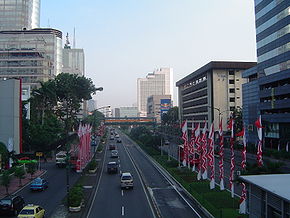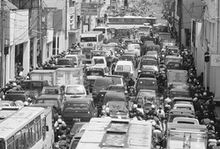Jakarta: From Global City to Ailing City
 The modern city of Jakarta was initiated by President Soekarno who has strong vision to build Jakarta into the greatest city possible (Cybriwsky and Ford, 2001). He gave Jakarta Monas –his most symbolic new structure of 132 m high national monument, spacious new government buildings, department stores, shopping plazas, hotels, sport facilities of Senayan that was used for the 1962 Asian Games, the biggest and most glorious mosque of Istiqlal, new parliament buildings and waterfront recreation area at Ancol.
The modern city of Jakarta was initiated by President Soekarno who has strong vision to build Jakarta into the greatest city possible (Cybriwsky and Ford, 2001). He gave Jakarta Monas –his most symbolic new structure of 132 m high national monument, spacious new government buildings, department stores, shopping plazas, hotels, sport facilities of Senayan that was used for the 1962 Asian Games, the biggest and most glorious mosque of Istiqlal, new parliament buildings and waterfront recreation area at Ancol.
Such constructions continued under the New Order regime that began in 1967. In the early administration of this regime, some projects were completed including the Ismail Marzuki Arts Center, industrial zones at Tanjung Priok and Pulo Gadung that aimed to attract foreign investment, and the unique theme park of Taman Mini Indonesia Indah.
During thirty-two years of the New Order regime, Jakarta has changed considerably. A generally rapid economic growth during this period allowed Jakarta to expand its modern constructions and develop a modern city. Firman (1998; 2004) noted that the physical development of Jakarta was resulted from its functions as a “global city” in Asia. The “global cities” in Asia include Tokyo, Seoul, Taipei, Hongkong, Manila, Bangkok, Kuala Lumpur, Singapura and Jakarta. Hundreds of new office towers, hotels and high-rise apartment-condominium building were built in many parts of the city.
In a recent article, Murakami and her colleagues (2005) compared the urbanization stage and patterns of land use in Jakarta, Bangkok dan Manila. Using the Clark linear exponential model and the Newling quadratic exponential model, they compared the spatial distribution of population densities in those cities. They also analyzed land-use patterns by examining the mixture of urban and agricultural land use. They found that Jakarta has entered the suburbanization stage, while Manila was at early stage of suburbanization and Bangkok was at intermediate stage of suburbanization.
A parade of tall buildings one after the other filled the major streets on both sides. They house the offices of Indonesian and multi-national corporations. Firman (1999) reported that total area of commercial space in Jakarta in 1978 was only 0.1 million square meters and in 1997 it reached 2.7 million square meters with nearly 90 percent of occupancy rates. In every parts of the city, modern shopping malls along with family enterprises were also built.
The economy crisis which hit Indonesia 1998 resulted in major disruptions on urban development in Jakarta. Such monstrous crisis has shifted Jakarta from “global city” to “city of crisis”. The crisis –commonly known in Indonesia as krismon- had largely squeezed the economy of Jakarta. Domestic and foreign investment dramatically declined. Many manufacturing and services corporations in Metropolitan Jakarta closed and laid off their employees, resulting in rapid increase of open unemployment.
In order to survive amidst the krismon, a large number of workers had shifted to become food traders or engaged in other informal sector jobs. Street vendors –commonly known in Indonesia as pedagang kaki lima- increased rapidly from about 95,000 in 1997 to 270,000 in 1999 (Firman, 1999). Increasing informal labor force is a distinctive characteristic of cities in developing countries since sector formal can not accommodate the large number of labor force.
The shrinkage of economic activities resulted in the decrease of office space demand. It dropped from 300,000 square meters in 1997 to 85,000 square meters in 1999. Similarly, the demand for high-class apartments dropped from 49,000 in December 1997 to 16,000 in February 1998. The housing market in Metropolitan Jakarta nearly collapsed due to increasing prices of building materials and housing loan interest rates. Most construction projects in the periphery of Jakarta slowed down or even completely stopped (Firman, 2004).
Firman (2004) argued that in the near future after the krismon, urban poverty was the most obvious issue on urban development in Jakarta. This includes job creation, basic need provision for the poor, improvement of living environment in slums areas and micro credit provision with low interest.
In order to mitigate the impact of the krismon, the government along with the assistance of IMF launched a variety of social safety net programs in July 1998. The programs include food security, employment creation, scholarship to students and block grants to schools, targeted health care subsidies, and community block grant (Sumarto, et. al., 2004). Political and economic reforms were also implemented during the recovery process.
Firman (2004) reported that by 2002 there were about three-fifth of the new town projects in the fringe areas of Jakarta still survived. The remaining was no longer in operation or terminated the projects due to the economic crisis. More than 450 developers went out of business during the krismon. Civil unrest and political uncertainty that heightened during the krismon reduced gradually during the recovery process. As of early 2007, Indonesia’s economic performance is more positive. In the last two years, Indonesia's economy has growing at a robust pace of 6 percent a year. As the capital and the center of economic, commercial and transportation hub of the nation, Jakarta has secured as the primary growth machine and has been recovering from the krismon.
Civil unrest and political uncertainty that heightened during the krismon reduced gradually during the recovery process. As of early 2007, Indonesia’s economic performance is more positive. In the last two years, Indonesia's economy has growing at a robust pace of 6 percent a year. As the capital and the center of economic, commercial and transportation hub of the nation, Jakarta has secured as the primary growth machine and has been recovering from the krismon.
While Jakarta is still not fully recovered from the krismon, the recent floods retard the recovery process. The flood which was blamed as the result of unsustainable development process in Jakarta and its extented region remind us that Jakarta is an ailing city. She needs major remedy for her illnesses to get back to be global city.
References:
- Cybriwsky, Roman and Ford, Larry R. (2001). City profile: Jakarta. Cities 18(3): 199-210.
- Firman, Tommy. (1998). The restructuring of Jakarta Metropolitan Area: A “global city” in Asia. Cities 15(4): 229-243.
- Firman, Tommy. (1999). From “global city” to “city of crisis”: Jakarta Metropolitan Region under economic turmoil. Habitat International 23(4): 447-466.
- Firman, Tommy. (2004). New town development in Jakarta Metropolitan Region: A perspective of spatial segregation. Habitat International 28(3): 349-368.
- Goldblum, Charles, and Wong, Tai-Chee. (2000). Growth, crisis and spatial change: A study of haphazard urbanization in Jakarta, Indonesia. Land Use Policy 17: 29-37.
- Murakami, Akinobu, Zain, Alinda Medrial, Takeuchi, Kazuhiko, Tsunekawa, Atsushi, and Yokota, Shigehiro. (2005). Trends in urbanization and patterns of land use in the Asian mega cities Jakarta, Bangkok, and Metro Manila. Landscape and Urban Planning 70: 251-259.
- Sumarto, S., Suryahadi, A. and Widyanti, W. (2004). Assessing the impact of Indonesian social safety net programs on household welfare and poverty dynamic. SMERU Working Paper
(This article also appeared at Urbanicity's City Matters Magazine on March 2007)




4 comments:
this is the magic of technology...
i really appreciate your initiation of this blog...
i hope it become our media to share any idea about urban development in INdonesia
-catur-
young planner
Catur: Thank you for your comment. Yes, my hope is we can use this blog to share or discuss any urban issue in Indonesia for the advancement of urban development in Indonesia. Please bring more attention of other young planners to our discussion in this blog and we contribute to making Indonesia's urban spaces better places to live.
Very informative post. Jakarta is a bustling town, you can find shopping centres and luxury hotels. Most of the people are involved in plantation, they mostly use motorbike taxis and three wheelers for this purpose. Majority of people work in metal shops, small scale factories and vending food. You may find brave people in Kampung Pulo located in the core of Ciliwung as they live happily despite facing flood problem.
Thank you for the posting. I am currently studying about the image of Jakarta, during the colonial era and post colonial era. There is a very distinct similarity in both in the sense that Jakarta has always been seen as an overcrowded port/town/city and the response of the habitats, permanent or temporary have not been favorable. Yet, it continues to lure people to come and maintains the residents to continue to stay there. This love hate relationship is very interesting. I do hope that those who dwells in the city would be more constructive rather than continuously complain about this great city. Cheers.
Post a Comment